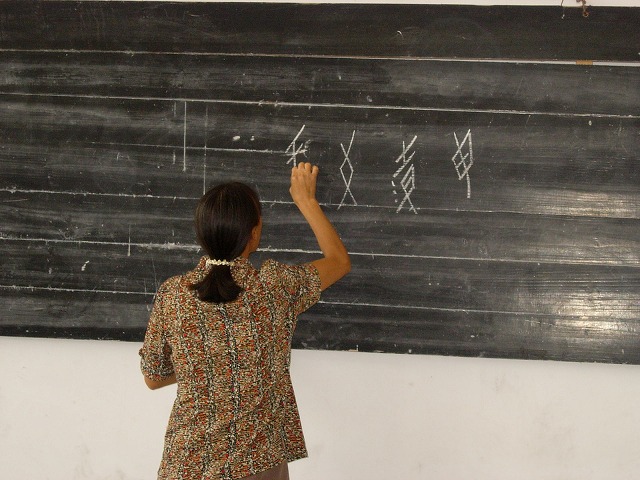 [Hu Meiyue胡美月]
[Hu Meiyue胡美月]
The Jiangyong Prefectural Government 江永県政府 opened the Nushu Culture Village女書文化村 in Autumn, 2002 at Shang Jiang Xu Zhen Pu Mei Village上江墟鎮普美村 and established the Nushu Plaza "女書園" there. When I started research on Nushu in 1993, the village name was described as "甫尾村"Pu Wei Cun, but later the description was changed to "普美村" Pu Mei Cun when the Nushu Culture Village was opened in 2002, replacing the second character 尾 (wei) 'tail' with 美 (mei) 'beautiful'. The new Chinese character has a similar pronunciation to the original and perhaps its meaning 'beautiful' was chosen to beautify the village name.
After visiting the village in November 2002, I reported on the Nushu Culture Village in my 2003 web site update. In 2002, I visited there the village as a participant in the "International Symposium on Jiangyong Women's Script" together with the Yao 瑶族 participants. There were many villagers demonstrating the making of folkcrafts and showing the ancient wedding ceremony. There were many souvenirs sold. The place was bustling with visitors.
This time, twenty-two months later, I visited the Nushu Culture Village again together with a group of 18, including a journalist, several researchers and tourists. We found the wall of the buildings discolored and the first floors showing evidence of leaks. I was especially surprised to find that we were the only visitors. The showcases were locked, and the attendant unlocked them only when we asked to examine the exhibits more closely. In a second glass case inside the showcase were two copies of original San Chao Shu 三朝書 (third-day missives), along with new reproductions, the materials on display were recently-made craftworks. There was no one to demonstrate making folkcrafts. There were only a few commodities on display in the souvenir shop, and in any event, there were no buyers. In less than two years, the place has deteriorated to a shadow of its former self.
The Nushu study room was large enough to accommodate about 40 students, but there were no students because it was a weekday. The teacher Hu Meiyue胡美月 took the trouble to come to meet us, however, and we learned how to write "Jiangyong Nushu" 江永女書 from her. She wrote four characters in a row, one by one, from right to left. Originally Nushu was written vertically, but she wrote horizontally.
 [Hu Meiyue胡美月]
[Hu Meiyue胡美月]
First, to write "
 " of "
" of "



 " (江永女書), she drew three horizontal but slightly slanted strokes from the upper right to the lower left and then drew a vertical stroke on the right, one on the left, and a long central line vertically. This stroke order is peculiar to writing Nushu, and is quite different from that for writing Chinese characters. The teacher taught this traditional writing order correctly. When I asked Hu Meiyue胡美月 more about her teaching method, she answered that she would sing a line of a poem and write it on the blackboard. Then the students copy it and sing. Next, she sings another line, and has them sing and copy that line, repeating the process until the song is completely written out on the blackboard.
" (江永女書), she drew three horizontal but slightly slanted strokes from the upper right to the lower left and then drew a vertical stroke on the right, one on the left, and a long central line vertically. This stroke order is peculiar to writing Nushu, and is quite different from that for writing Chinese characters. The teacher taught this traditional writing order correctly. When I asked Hu Meiyue胡美月 more about her teaching method, she answered that she would sing a line of a poem and write it on the blackboard. Then the students copy it and sing. Next, she sings another line, and has them sing and copy that line, repeating the process until the song is completely written out on the blackboard.
At the time of my last visit, there had been many Nushu works made by students displayed on the wall of the study room, but this time I found none. I asked Hu Meiyue胡美月some questions about students:
Q: How many students do you have at present?
A: About 40 in total.
Q: For what purpose do the girls study Nushu?
A: Since Nushu exists only in this area and was transmitted by Gao Yinxian高銀仙 (see below), they want to study and transmit Nushu to posterity.
Q: Do young girls really think like that? Don't they have a more concrete purpose? For example, to sell Nushu embroidery works to tourists and so on.
A: Yes, some do. And , I also hear that some girls who finished their study here and who are now working away from home gather to sing songs together so as not to feel homesick.
Her answers seemed rather exaggerated and idealistic. In contrast, He Jinghua何静華(mentioned below), with whom we had met the day before, had said that there were no students at present, and that even some junior high school girls who would agree to attend the class would only do so if they were paid five yuan each time.
With Hu Meiyue胡美月 saying there were 40 students and He Jinghua何静華 saying there were none, it is hard to assess the continued popularity of the lessons in the script and/or the production of new works. And the claim that young girls come all the way to the Culture Village to learn Nushu simply with the altruistic aims of become able to transmit this script to others strikes me as dubious. At the time of our visit, no students were available to interview. Whatever the number of such students or the nature of their motives, however, my own observations on this visit suggest that the Culture Village is not flourishing.
Gao Yinxian高銀仙 was one of the few transmitters alive, along with Yi Nianhua義年華 (Note 1), when researchers went to Chongyong Prefecture 江永県 for research and study of Nushu script 女書 after it had been discovered and introduced to the public in the 1980s. She knew the characters, songs and folklore well. She left a lot of written and audio materials and continued to make great contributions to the study of the script until her death in 1990. [no paragraph break] Hu Meiyue胡美月 is a granddaughter of 高銀仙 and is identified as a legitimate transmitter; she is certified as a "the Nush transmitter" by the prefectural government, as noted below. She has a strong sense of mission to transmit the script, and might have given us guarded, "unimpeachable" answers to our questions.
(Note 1) A woman who contemporaneous with 高銀仙, who contributed to the study of the script as a transmitter of Nushu and who left many text and vocal data when she died in 1991.
When I asked a guide from the tourist bureau how many visitors a month there were on average, she answered that she did not know exactly because the number of visitors varied month by month and no statistics were kept. When I pressed her for a rough estimate of the number of visitors, she answered that they had quite a number of visitors when students came on field study trips with their teachers, or when prefectural and city administrators visited with their subordinates. However, a report (Note 2) dated March, 2004 written by Zhang Aiguo張愛国 (Note 3), a secretary of the prefectural government, notes that "there were a little more than 10,000 visitors since last year." If the number was counted from the opening of the culture village, then there were 10,000 visitors in 15 months, which is 670 visitors a month or around 20 a day.
(Note 2) The secretary of a prefecture is the highest executive of the prefecture and corresponds to a governor in Japan.
(Note 3) "江永県抢救保護和発展女書所做工作的状況汇報" by 張愛国(2004) (P.101 in "女書的歴史現状和未来" 国際研討会論文汇編)
The same report goes on to describe governmental policies for the culture village and the Nushu script as follows:
"Preservation (literally, "protection") cannot be continued unless there is a plan for development. Any development with no plan for preservation, however, would not be basic development. Both the committee and the government of Changyong Prefecture have been working actively to recover Nushu culture, always in principle attaching a great and equal importance to preservation and development. We decided on the tourism development plan for the Nushu culture village highlightin the outstanding aspects of Nushu culture, and we built the Nushu Culture Village in Shang Jiang XU Zhen Pu Mei Village上江墟鎮普美村. Thus, by activating the Nushu culture tourism project, we were able to improve the status of Nushu script from of cultural resources to actual productivity. We established a Nushu plaza in the culture village, where we built a display room for Nushu works, a Nushu study room, a Nushu art room, Nuhong shi女紅室 (Note 4), and so on. We have developed and protected the Nushu Culture by harmonizing it with the local products and customs."
(Note 4) "Nuhong女紅" is a general term for women's manual labor, e.g., spinning, weaving, embroidery, sewing, making cloth shoes and so on; and a room for showing such work is also called "Nuhong shi女紅室
The secretary says positively that they "activated the tourism project" and "developed and protected the Nushu culture", but the prefectural government's steadfast policy is to make use of Nushu for local development. The prefectural government considers it possible to preserve and protect Nushu as a result of economic effects by developing tourism. However, their plan seems not to be successful so far. It may have been because the day when we visited the village was a weekday so that our group of 18 were the only visitors. But the place was not lively, and there were few works worth seeing on display in the display room and data room. There was no evidence of the "preservation" of Nushu. There was a great difference between the secretary's report and the actual state of the Culture Village that we saw.
In October, 2003, the Jiangyong Prefectural Government 江永県政府 granted five women the title of "Nushu transmitter" 女書伝人 Nushu Chuan Ren, along with a monthly subsidy of 20 yuan. The women awarded this official "certification" are Yang Huanyi陽煥宣、He Yaxin何艶新、He Jienghua何静華、Hu Meiyue胡美月 and Yi Yuanjuan義遠絹.
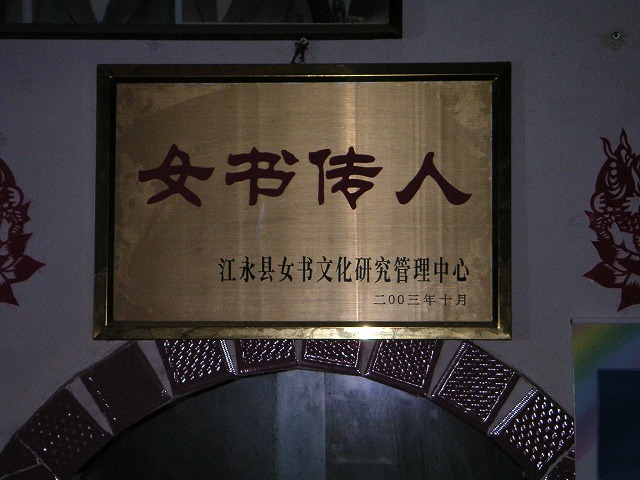 [Certification of transmitter of Nushu]
[Certification of transmitter of Nushu]
Yang Huanyi陽煥宣 fully commanded the script in her girlhood, and surely deserved this recognition. Sadly, she passed away on September 20, just two weeks after we visited her. He Yanxin何艶新 did not use the script in her girlhood, but she learned it from her grandmother and can create her own original emotional poems like women in earlier times, so she also deserves the title. The other three women, however, differ from these two women both in their process of transmitting the script and in their capacity to do so.
He Jinghua何静華 helped me as an informant when I conducted research on the old poems in 1997. At that time, she came to appreciate the value of the script and since then, has studied it by herself from books. Hu Meiyue胡美月 is the granddaughter of Gao Yinxian高銀仙, but it does not necessarily follow that she learned the script from her grandmother in her girlhood. I will return to this point shortly. I have never met the last woman, Yi Yuanjuan義遠絹, but prefectural secretary Zhang Aiguo張愛国's explanation mentions that she is the wife of the grandson of Gao Yinxian高銀仙 (Interview, September 6, 2004). I have been going to Changyong prefecture every year since 1993 and have visited the house of 高銀仙four or five times. Although I have met her grandson and his wife, I have never seen her writing Nushu nor I have ever been shown any of her works. Her name has never appeared in the research papers by Chinese researchers. As part of the family of 高銀仙, she seems to have suddenly emerged as a transmitter.
According to Zhang Aiguo張愛国, the criteria for selecting authorized transmitters is that a woman can sing traditional songs, write and read the script, write poems, and that women selected must be generally acknowledged to deserve the authorization. The prefectural government does not take into consideration of the fact that those five transmitters are considerably different in ability. The three women other than Yang Huanyi陽煥宣 and He Yanxin何艶新 may technically meet the criteria, but that is within the scope of being able to master characters by second-hand learning. As only the writing of the characters is possible by learning them in this way, only the transmission of the forms is possible. But the sentiments that women in the old days conveyed when they created, used and transmitted the script cannot be recovered in this way. It is difficult to master the unique form and style of the characters and to absorb the sentiments they originally were designed to convey when studying by oneself. These days it would be almost impossible to write such sorrowful poems as those composed by a sworn sister on parting by marriage in earlier eras due to changes in the social environment. It is only Yang Huanyi陽煥宣 and He Yanxin何艶新 who barely could make such poems. However, 陽煥宣 is gone and 何艶新 says that she is not willing to write Nushu because it recalls the bitter experiences of her youth.
Consequently, the three additional women have been brought to the fore as authorized transmitters. These "transmitters", authorized by the prefectural government but in my opinion of somewhat lesser qualification, will act independently from this point on. It is to be hoped that the prefectural judgment has not been led by its officially stated plan to preserve and develop Nushu into overly generous authorizations.
(Note 5) A professor of Qing Hua Daxue清華大学, who started to study Nushu in the 1980s and stands foremost among the scholars of Nushu in China at present.
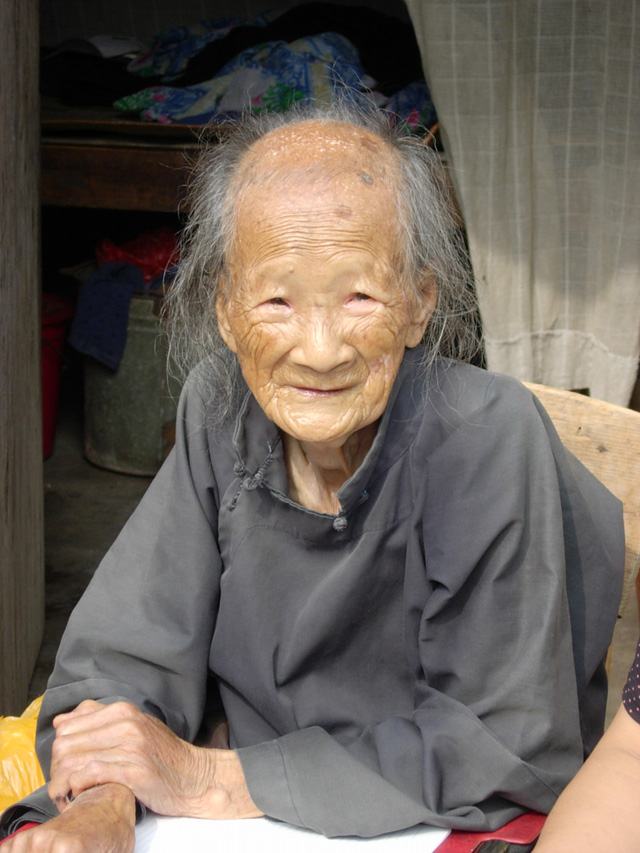 [Photo by Timothy O' Rourke]
[Photo by Timothy O' Rourke]
We visited her on the morning of September 7 at the Tongshanling Farm 銅山嶺農場. She looked smaller than when I had met with her in 2002. Upon seeing me, however, she offered her hand happily. Outside her dark, narrow room, she willingly answered our questions and sang and wrote Nushu for us for about an hour. I was later informed by Beijing that she had died on September, 20. The Japan Times also reported her death. It was incredible to me that the woman who had pleasantly sung songs for us just two weeks before was no longer with us.
When I planed our recent visit to her, I admit that I was greatly apprehensive. When a friend visited her this March, she was almost too weak to talk. She could neither write nor sing songs. When we visited her, I wondered if we would even be able to see her. But when we arrived for our recent visit, we found that she had got up from her bed to meet us. And although I first thought that just seeing her would be enough, she looked so well and happy to see us that I asked a little about her daily life and then, more boldly, whether she could still write Nushu. "Yes, I can", she answered. I was happy to hear that. In a flurry, I took out a ball-point pen and a piece of paper for her, but she could not use the pen well. Then I borrowed a pen that was easier to use from my friend. I usually carry a felt-tipped pen, which is soft and easy to write with, with me, but that day I had brought no such pen, because I thought it would be impossible for her to write due to her advanced age and weakened condition. That was my happy miscalculation.
Furthermore, I was tempted to ask her to sing a song, which she willingly did. I was much relieved to find that she could still write, sing and respond to all my questions and left with my initial apprehensions allayed. I thought as I left that the last transmitter of Nushu would still be fine. So I was shocked and saddened to learn of her passing. And, since she has passed away, it will be still more difficult to transmit Nushu in its original form. I fear that we have seen the final phase of Nushu at last.
The following are the details of my interview with Yang Huanyi陽煥宣 on September 7, 2004:
First, I asked her age, and she answered she was 98 or 99 years old. The latest book in the collection of Nushu works by Yang Huanyi陽煥宣 introduces her as "a 100 year old Nushu woman" ("百歳女書老人、陽煥宣女書作品集" written by Zhao Liming趙麗明 and published by Guoji Wenhua Chuban Gonsi国際文化出版公司), but then states that she was born on July 2, 1909. The guide from the prefctural government, however, said she was born in 1906. According to this, an age of 98 or 99 would be correct. There is, thus, a three-year discrepancy between the official view and the scholarly view of her age. This requires clarification, both with respect to her actual birth date and with respect to the evidence offered for the two differing dates given.
Next, when I asked Yang Huanyi陽煥宣 to write something for me, she wrote my name first, after asking the interpreter what she should write. Though the visit was after a lapse of 22 months, she remembered me perfectly and wrote the accustomed characters for my name. Next, she wrote the following Nushu characters (Fig. 1).
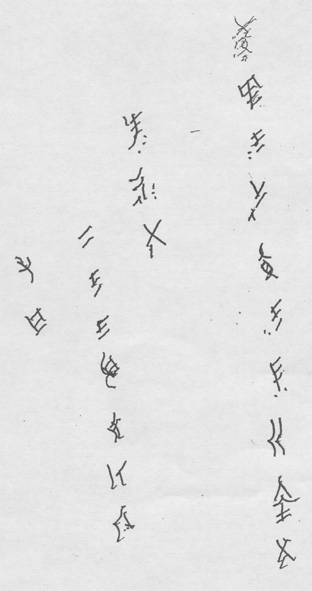 (Fig. 1)
(Fig. 1)
They are translated into Chinese characters and English as follows:
"遠里老師斉到来没有歓待。(All of you have come to see me from far away, but I am sorry I have nothing with which to entertain you warmly.)
Yang Huanyi陽煥宣
September 7, 2004
On this day, too, Yang Huanyi陽煥宣 a writing brush firmly and wrote for us without trembling. The characters were a little disordered in form, but she wrote with attention. She said again that she was sorry for her inability to entertain the visitors coming to see her from so far away. She also sang in a beautiful voice. The song she sang was "一取天上娥眉月 二取獅子槍秀球 三取三星三結義......(One, a new moon, Two, two lions competing a decorated ball, Three, three heroes get together and brothers...), which is often sung by women in this district. Her voice has not so full of life as when I first heard her sing in 1993 and her voice had weakened, but her intonation was as profound and moving as ever. When I asked her whether she still wrote Nushu, she answered that she would write if asked.
When a journalist from England who had joined our tour asked her who she had learned Nushu from, she answered she learned from 義早早. This is the same transmission route as I had heard from her previously. Moreover, she told she had had three sworn sisters Jiejiao Zimei結交姉妹, and had written some copies of San Chao Shu三朝書 as requested. There was no discrepancy between the information and what we had heard from her in the past interviews.
Every time I saw Yang Huanyi陽煥宣, I admired her excellent memory and clear head. This time, too, I her responses to our questions and requests as precise and intelligent. Thinking that she would be still all right for some time, I told her, that I would return again and, urging her to take care of her health, I left her home.
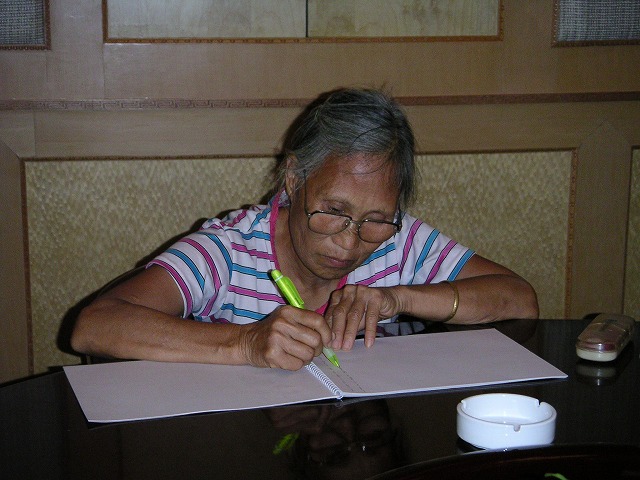
When I met He Yanxin何艶新 again the summer, the first thing she told me was that her grandson was in the hospital with a serious illness, that she felt worried and sad for him, and that the whole family was troubled over the expensive hospital charges. I asked her to write a poem to express her feelings in these circumstances, and she took quite a long time to write the following poem in Nushu, which is translated to Chinese characters below:
 (Fig. 2)
(Fig. 2)
来到江永把筆写 没成修書先泪垂 左思右想心不安 孫児得病骨髄炎
如今住院一月満 不知要用多少銭 眼看孫児心中痛 看見開刀苦難当
毎次来看双流泪 孫児幾時身健康
(When I try to write something in JiangYong, my tears come down for the first. My thoughts swirling about in my heart, because my grandson is suffering a heavy osteomyelitis .Now he has been in hospital for a month, and I don't know how much it will cost us. Seeing him suffering the pains, I slso feel pains in my heart. Seeing him being under the knife, I don't know how I can go through. Any time I visited him I could't help crying. I don't know when he can get well again.)
The style of the poem includes traditional phrasing, especially, the third phrase "左思右想心不安" (My thoughts swirling about in my heart) which was traditionally used by women. The poem describes her painful state of mind, with the double burden of her love for and worry over her grandson and the family's financial difficulties.
The following are excerpts from my interview with He Yanxin何艶新:
Q: How are you doing these days?
A: My 9-year-old eldest grandson had an operation for osteomyelitis and is now in hospital, so we are pressed for money at present. The operation cost us 10,000 yuan. My eldest son paid 3,000 yuan, but he could not afford to pay any more, so he asked for my help. Today, as usual, I have been to the hospital to visit my grandson. Whenever I go, he cries and asks me not to leave, so I feel very upset.
Q: When you write Nushu, what feelings do you have?
A: I write my biography describing the difficulties of my life with my parents and other difficulties throughout my life. While I am writing, I sometimes weep. Sufferings and sorrow are the themes of most Nushu works.
Q: When you received your framed certificate as an official Nushu transmitter "Nushu Chuancheng Zhe女書伝承者," what did you think of it?
A: Nothing special. I receive 20 yuan a month, but when I bought a bunch of grapes for my grandson, they cost 18 yuan. Nushu transmitters should train young girls as Nushu writers. My youngest daughter has come to be able to write, but she has not yet mastered the melodies of Nushu songs, so she can't sing. She can write poems like "Zhun Ying Tai祝英台," "Zhang Shi Nu張氏女" (Note 6) and some folk music, but can't sing.
(Note 6) Both "Zhun Ying Tai祝英台"and "Zhangshi Nu張氏女" are famous folktales.
Q: Do the young women understand the sorrowful feelings of women in the old days?
A: These days, youngsters would seldom experience great sorrow, but when my daughter lost her father, she grieved over his death, too. Now that she has come to read my biography, she was weeping while reading. Nowadays, we live in a world o equality of the sexes, and, fact, women are rather stronger than men, so young women would seldom have the opportunity to sing sorrowful songs.
Q: Did your mother have sworn sisters?
A: No, I don't think she had. Even when her relatives visited us, I've never heard her singing together with them. She receive San Chao Shu三朝書. When she was young, there were still 三朝書 being written. Women in Shangjiang Xu上江墟 who wanted to have one came to ask my grandmother to write one for them. She had gone to school, so she could read and write Chinese characters. She died at the age of 86. We buried 三朝書 with my grandmother. After the liberation, my grandmother continued to write Nushu until I was 13 years old. After that, she never wrote, because old customs came to be criticized. My mother also could read Chinese characters.
Q: Do you teach Nushu?
A: There used to be some girls asking me to teach Nushu, but I don't like to because it is not pleasant for me to write Nushu. I don't want to teach anyone besides my daughter.
Q: Do you usually write Nushu?
A: If I am asked, I will write, but usually no.
Q: What do you think of the Nushu characters written by He Jinghua何静華?
A: It's an awkward question for me. Her writing is beautiful, but mine is not. The letters written by Yi Nianhua義年華 and Gao Yingxian高銀仙 are thin and small. Those written by He Jinghua何静華 are long and curved. Zhao Liming 趙麗明 asked me to correct errors in the characters in the Nushu dictionary "Nushu Zidian女書字典" compiled by Zhou Shuoyi周碩沂 (Note 7), but I refused for fear of getting on bad terms with him. Zhou Shuoyi周碩沂 pointed out that my writing is wrong, but I learned the script from my grandmother, so whether it is correct or not, I can't help it."
(Note 7) A man who started to collect and investigate Nushu works in the 1950s. He compiled a Nushu dictionary "Nushu Zidian女書字典" (published by Yuelu Shushe岳麓書社) in 2002 containing the Nushu characters he collected to that point. He is criticized for including some characters he coined himself.
He Yanxin何艶新 says that she does not like to write or teach Nushu because she is not happy when she writes. This points to the essence of the traditional usage of the script. In this, she stands in contrast to He Jinghua何静華 who actively writes Nushu and distributes her works. 何艶新 is likely to avoid critical comment on 何静華's writing, as they live near each other and she would want to maintain a comfortable relationship with her.
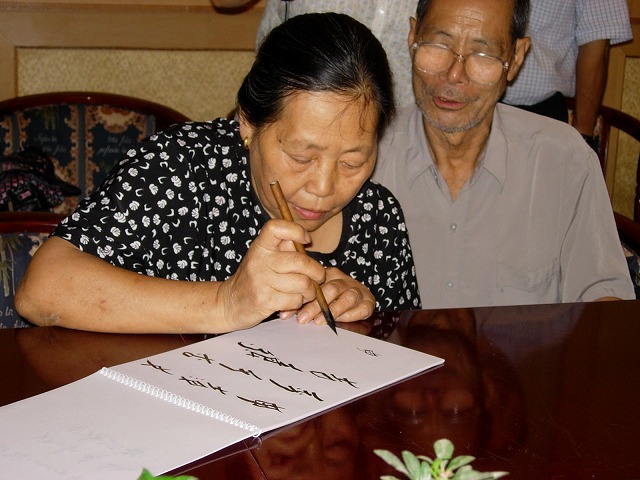
Why He Jinghua何静華 started to write Nushu in 1997 was described above. When she visited us at our hotel this summer, she brought three cloth-bound booklets in the form of San Chao Shu三朝書. Their general format, size, the way they are sewed, the red cloth pasted on the upper right and lower right in cover are the same as that of a traditional 三朝書, but there are also many differences [Photo]. The following is a comparison table.
| Traditional San Chao Shu三朝書 | "San Chao Shu三朝書" made by He Jinghua何静華 |
|---|---|
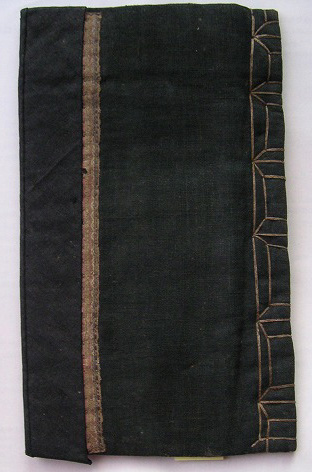
| 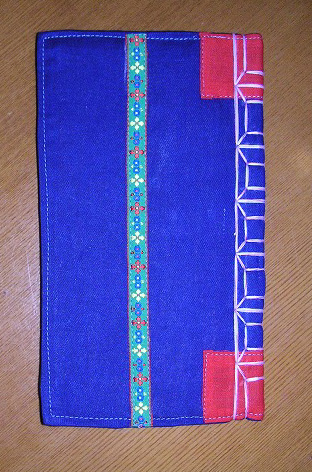
|
| Item | Traditional San Chao Shu三朝書 | "San Chao Shu三朝書" made by He Jinghua何静華 |
|---|---|---|
| 1.Color of cloth cover | Black | Bright, dark blue |
| 2.Change of cloth in cover | Two pices of the same cloth are used, with one section sewed to the other on the bias at three fourths of way across the width of the cover and the seam covered with ornamental tape. | No change of cloth |
| 3.Texture of left edge | Bias-cut texture is used where cloth is changed. | One piece of regular texture |
| 4.Position of ornamental tape | Pasted at one fourth of the distance from the left side so that the seams of cloth as it is changed do not show. | Pasted almost in the center of the booklet. |
| 5.Sewing | Hand-sewed | Machine-sewed |
| 6.Number of leaves | Limited to three leaves with six pages of Nushu writing | Most booklets have more than five leaves Nushu writing |
Among these differences, Items 2 and 3 are especially important, but He Jinghua何静華 ignores these vital traditions. Women in the old days did not use only one piece of cloth for covering 三朝書, but changed cloth three fourths of the way through the book, biased from the center of the booklet to the left, where they used biased cloth. At first glance, it looks as if the same cloth is used, but the arrangement of the biased cloth made the part of the booklet where the pages are frequently turned durable. It was fine and elaborate workmanship. Moreover, all San Chao Shu三朝書 were made in the same way. Thus, the traditional 三朝書 shows women's deep attachment to this form of expression and their elaborate workmanship. The beautiful covers typically manifest the emotion in the booklet. This vital point is not considered by 何静華.
In the future, more genuine三朝書 are unlikely to be found, and if those made by 何静華 go out in the world in increasing numbers, they may influence the transmission of the Nushu script in negative ways.
As to Item 6, the number of leaves of Nushu booklets is problematic. Traditionally, one booklet had about ten sheets of paper bound, but only three sheets (6 pages) were used for writing poems. The remaining sheets were used for embroidery thread, paper patterns, or cut paper, which were placed between the blank leaves. They were never written on. This was the typical way of using 三朝書.
He Jinghua 何静華, however, uses any number of sheets for writing without regard to tradition. And what is worse, the characters in her booklet are different from the traditional ones both in kind and in form. The characters are written in an affected style, in an attempt to make them look better.
Below is a comparative table of the handwriting styles of He Jinghua何静華, He Yanxin何艶新, Gao Yinxian高銀仙 and Yi Nianhua義年華:
| ①He Jinghua何静華 | ②He Yanxin何艶新 | ③Gao Yinxian高銀仙 | ④Yi Nianhua義年華 | |
|---|---|---|---|---|
| (来)lφ42 | 
| 
| 
| 
|
(仕)sw 33 33
| 
| 
| 
| 
|
| (有)hou21 | 
| 
| 
| 
|
| (到)lau21 | 
| 
| 
| 
|
At a glance, one can see the beauty of He Jinghua何静華's script. She extends the vertical line to an extreme degree, to display the character's elegant beauty. Other transmitters' letters have no such exaggerated lines.
As to character's arrangement on the page, the traditional poems have no
breaking space after seven letters, and a writer begins a new line anywhere
she likes. 何静華, on the other hand, begins a new line exactly at every seventh
letters. [Fig. 3, 4 &5]
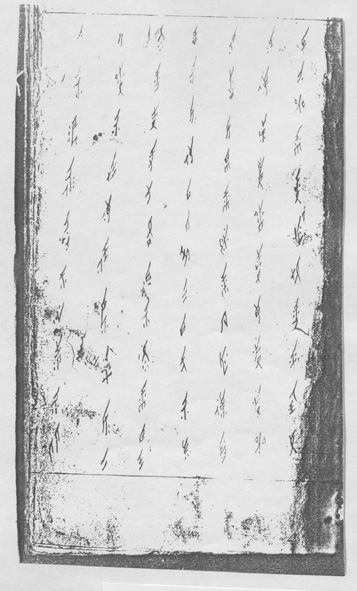 [Fig. 3]
[Fig. 3]
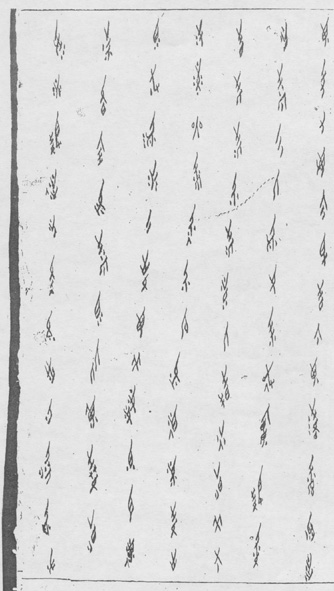 [Fig. 4]
[Fig. 4]
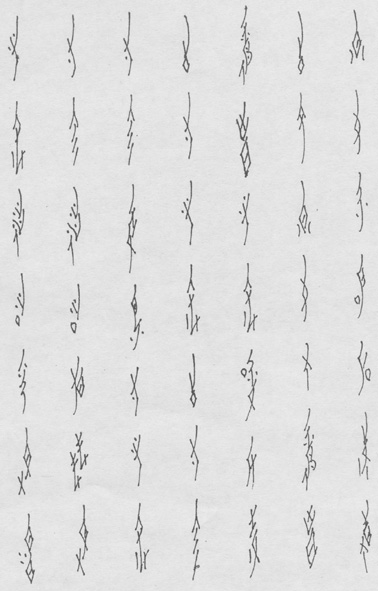 [Fig. 5]
[Fig. 5]
Fig. 3 shows that a poem an old San Chao Shu三朝書(no.1) that has 11 letters in the first, second and third lines, and 12 in the fourth linre, Fig 4 also shows that a poem in another 三朝書(no.2) with 13 letters in the first line, 11 in the second, and 12 in the third. The number of letters in each line is variable. An inspiration or emotion rushes out of the writer onto the page, without undue concern for form. Women wrote freely as she liked.
Fig. 5 is a poem by 何静華's. It is so arranged so that each line has exactly seven letters, which surely looks well-ordered, beautiful and easy to read. However, this is very different from the mode of expression of women writing poems in the traditional style, with emotion prior to form.
I asked 何静華 about this point and her somewhat awkward answer was as follows:
"In the past, I have written Nushu at the request of the publicity department of the prefectural government. They brought me an old 三朝書 made in Qing dynasty 清代 and a blank 三朝書 (Note 8). They asked me to copy the characters written in the old booklet to the blank one. The characters in the old booklet were not neatly arranged so that the number of characters in each line varied. And as the breaks between phrases and the start of a new line did not correspond, I though the poem might not be easy to read. So I copied the characters as they fit into phrases, line by line separately." This new way of arranging the Nushu poems is what she copied into the blank 三朝書 and returned to the prefectural authorities.
(Note 8) While walking from one village to another in search of original Nushu works, I often came across blank 三朝書 made by women in previous eras. Most of the booklets with characters written in them have already been discovered and very few may remain undiscovered, but blank booklets still remain in the villages.
It follows that the appearance of 三朝書 is traditional in one sense, but since the characters are arranged by 何静華 in this new way, that she has effected a radical break with tradition.
Without knowing about these changes and the rationale for them, anyone looking at it and seeing it displayed under government auspices could confuse it with a traditional one written by a woman in earlier times, and misunderstand the nature of the original 三朝書.
He Jinghua何静華 says that she is definitely well-off and has sufficient spare time, so she likes to sing songs and write Nushu as a hobby. If visitors ask her to write Nushu, she is quite willing to accommodate them. Such a positive attitude is convenient for the prefectural government, who finds her useful in promoting Nushu script as a cultural resource and who granted her the title of "Nushu Transmitter." Being pleased with this, she has been even more actively striving for publicity of Nushu.
The production of new works of Nushu that exhibit significant differences from the traditional character forms and page arrangements without proper description of or explanation for these changes fills me with apprehension. A new problem has arisen, in addition to the problem of possible loss of the script: that is, how to stop the dissemination of new styles as if they were the traditional style, without any acknowledgement of the differences that are being incorporated into the new works.
The following is a summary of what I heard from Hu Meiyue胡美月 about the Nushu transmission process over the course of two interviews.
March 1997
In my girlhood, I knew that my grandmother wrote Nushu, but I did not feel inclined to learn it. In the beginning of the 1980s, when my grandmother became famous, and scholars and mass media people came to visit her, I realized that the script was valuable. I knew that when my grandmother died and she was, at the time, quite advanced in age, the script would disappear, so I started to learn it from her in 1985, when I was 23. However, by then, I was already married and no longer lived with my grandmother, so I did not have enough time to learn. I can copy a poem, but I cannot put down in writing what I have in mind.
November 2002
I teach Nushu at the Nushu School "Nushu Xuetang女書学堂" in the morning and on Saturdays and Sundays afternoons. Before the study hall was built, I taught in another house as a volunteer starting in the spring of 2001. Now there are 20 to 30 students, girls and women ranging from 10 to 50 years old and living in Pu Mei Cun普美村. There no students from other villages. After leaving school, many of the girls go away from home to work, so there are few students who can continue to learn. There is no school fee; teacher is paid by the prefectural government Hu Meiyue胡美月's attitude is one of a sense of mission, as is described in section 1 above. When I visited her in 1997 and 2002, she said she could not write her own poems, but on this visit she showed me some poems she had written. While teaching, she may have become able to express her feelings in Nushu, the harmony of the script with the sound of the dialect. [Fig. 6] is one of her poems.
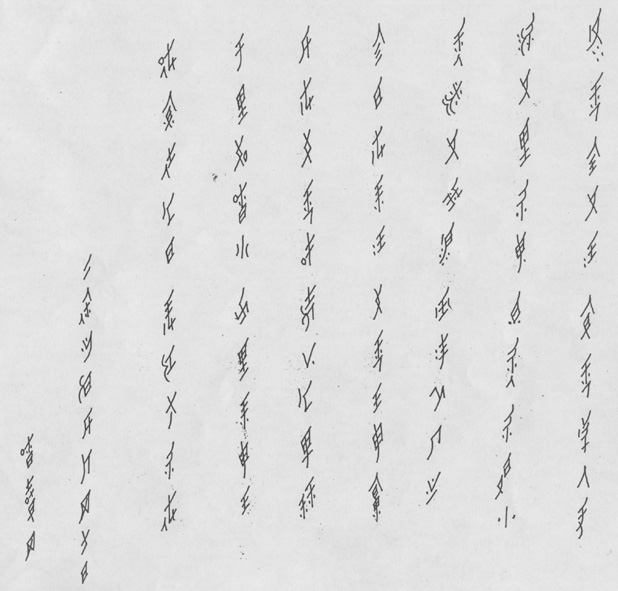 [Fig. 6]
[Fig. 6]
修書伝文到 識書字人看 差文理不深 請你不取笑
我的文学低 用時方知少 今日以来到 女書園中会
咱与才書通 結下好姐妹 千里如湖来 万里来共水
相識是好日 長行義不休
(When you receive this letter from me, don't laugh at me for my simple words and expressions. My level of writing is not high and I'm regretting not having been studying hard before. Today you came and met me here in our Nushu School, we became friends by writing each other. You came from far away and we got to know each other. It is so wonderful! Perhaps you'll leave tomorrow, and we don't know when we can meet again, but our friendship will last forever.)
This is a formal poem, not one that expresses her emotions. Ardent feelings like those expressed in He Yannxin 何艶新's poems are not present.
As Hu Meiyue胡美月 is a granddaughter of the famous Gao Yinxian高銀仙 and has a strong sense of mission, she may be a suitable teacher at the Nushu study hall, but she is no match for He Yanxin何艶新.
On my most recent research visit, I learned clearly what the prefectural government's point of view on Nushu is and what measures they are taking at present. That is, rather than respecting the original form of Nushu and working toward its preservation as a style faithfully following the Nushu tradition, they are privileging its utility in the development of the tourist industry.
This valuable script which women in this local area created by themselves and which has been continuously transmitted from generation to generation as a means of expressing their lives' sorrows and of comforting each other is at the mercy of business development just at the point of its likely extinction.
Rather than leaving shell of the script modified and distorted from its original purpose to the point where it may give rise to misunderstanding by future generations, it would be better to leave the existing Nushu works to go to ruin naturally.
What we must do now would be to discover as many extant original Nushu works left by traditional women as possible, to preserve them as they are and to digitally record them so as to leave genuine texts for the future.